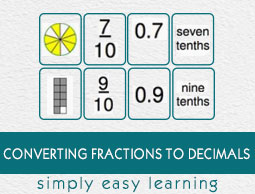
- Converting Fractions to Decimals
- Home
- Writing a Decimal and a Fraction for a Shaded Region
- Converting a Fraction With a Denominator of 10 or 100 to a Decimal
- Converting a Fraction With a Denominator of 100 or 1000 to a Decimal
- Converting a Proper Fraction With a Denominator of 2, 4, or 5 to a Decimal
- Converting a Mixed Number With a Denominator of 2, 4, or 5 to a Decimal
- Converting a Fraction to a Terminating Decimal - Basic
- Converting a Fraction to a Terminating Decimal - Advanced
- Converting a Fraction to a Repeating Decimal - Basic
- Converting a Fraction to a Repeating Decimal - Advanced
- Using a Calculator to Convert a Fraction to a Rounded Decimal
- Converting a Mixed Number to a Terminating Decimal - Basic
- Converting a Mixed Number to a Terminating Decimal - Advanced
- Ordering Fractions and Decimals
Converting a Fraction With a Denominator of 10 or 100 to a Decimal
Introduction
We should recall decimal place value charts. We know that, to the right of a decimal, the places values are the tenths, hundredths, thousandths and so on.
The rule says that the decimal point in the numerator shifts to the left as many places as the number of zeros after 1 in the denominator.
Consider here, fractions with denominators of 10 or 100
Rules to convert a fraction with a denominator of 10 to a decimal
Suppose we have a fraction $\frac{7}{10}$.
At first, we write the numerator 7 only.
Then we look at the denominator which is a ten which corresponds to the decimal place value tenth. So, 7 has a place value of a tenth. For this we put a decimal point before 7. So, $\frac{7}{10}$ becomes the decimal .7 or 0.7
Alternately, as the number of zeros in a 10 is 1, the decimal shifts one place to the left in 7 to make it 0.7
Rules to convert a fraction with a denominator of 100 to a decimal
Next consider a fraction $\frac{97}{100}$.
At first, we write the numerator 97 only.
As we were dividing with a 100, we are looking at a place value of a hundredth. The digit 7 has a place value of a hundredth. So, a decimal point is put before 9 and we get $\frac{97}{100} = .97$ or $0.97$.
Alternately, as the number of zeros in a 100 is 2, the decimal point shifts two places to the left in 97 to make it 0.97
Example 1
Write $\frac{6}{10}$ as a Decimal.
Solution
Step 1:
At first, we only write the numerator 6 as 6.0
Step 2:
Since the denominator 10 has a single zero, we shift the decimal point in 6.0 one place to the left and get .6 or 0.6 as the answer.
Step 3:
So, $\frac{6}{10} = 0.6$
Example 2
Write $\frac{48}{100}$ as a decimal.
Solution
Step 1:
At first, we write the numerator 48 as a decimal 48.0.
Step 2:
Since the denominator 100 has two zeros, we shift the decimal point in 48.0 two places to the left, and get the answer as .48 or 0.48
Step 3:
So, $\frac{48}{100} = 0.48$